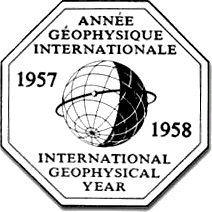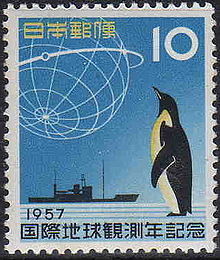by Larry
November, 2012IGY - July, 1957, through December, 1958
Under Ms. Harrington's influence, though, I won prizes for a couple science projects, on "Artificial Ecological Systems" and "Motility in Protozoa," and enjoyed being kind of a geek or "prof," as my schoolmates nicknamed me, researching and giving talks to the class on matters scientific. In this I benefited from being in a fairly small "pond," for I definitely was neither in a big pond nor even a big fish scholastically, yet still gained recognition as something of a nerd. Adding to the notoriety, I also tutored a few younger students in math and hung out with a brainy guy, my preacher's son, who would later become an engineer. One topic on which I lectured at the time (the spring of 1957) was the then upcoming International Geophysical Year (IGY), due to commence in only a few more weeks or months, in July of that year. Little did we guess how remarkable IGY would become to most all of us or to what fascinating outcomes it would lead. At least within popular conception, The International Geophysical Year would be the forerunner of much study of the world as a whole, taking Earth into account as an integrated system of forces and how they are balanced. It was a comprehensive attempt to bring cohesion to the scientific endeavors of many nations. A number of areas would receive special focus: the aurora, cosmic rays, geomagnetism, gravity, ionospheric physics, global mapping, meteorology, oceanography, seismology, and the influence of solar activity on our planet. There would be investigations in the Arctic, at or near the Equator, at great depths in the sea, in the upper atmosphere, in space, and in Antarctica. Much cooperative effort went into this last emphasis, about which there was till then surprisingly little known.
Overall, IGY helped scientists study space, measure great depths and ages of polar ice, understand earthquakes better, learn about intense solar radiation (that would prove particularly hazardous to people in space), discover mid-ocean submarine ridges and the Van Allen radiation belts, and increase their knowledge of glaciers. IGY also set the stage for greatly enhanced weather and climate forecasting. Concerns over our major adversary's evident capacity, after its IGY accomplishments, to spy on us at will or even to launch missiles down upon us from orbits only 100 miles above, as well as embarrassment with the laggard state of our own space program, helped convince President Jack Kennedy a few years later to begin the ultimately triumphant National Atmospheric and Space Agency (NASA) project of landing a man on the Moon. Expanding its mission to meet this challenge led as well to the many additional NASA accomplishments we almost take for granted today. Advances in computing, micro-circuitry, miniaturization, communications, and even the internet were related to such early efforts and have phenomenally transformed technology and thus our very way of life. Such achievements, wedded to their military and economic consequences, put us so far ahead of the Soviets that their system could not adequately keep up and eventually, in 1989, collapsed. Initially the idea, as I understood it, was to have a succession of IGYs. Somehow this never took place. However, there was to have at least been in 2007 a 50-year commemoration of that signal scientific event. The idea as expressed within the U.S. legislative body was to have combined it with the launching of an "International Geophysical Year Two (IGY-2)." Toward this end, there is a Congressional Record summation of IGY's relevance, as follows:
"The 60 nations and 60,000 scientists who participated in the IGY left an ongoing legacy beyond measure. Satellite communications, modern weather forecasting, modern natural disaster prediction and management, from volcanic eruptions to El Nino--are all legacies of IGY scientific activities that covered the globe and breached the space frontier. We are as yet awaiting IGY-2, but perhaps it is fair to say we are still digesting all the gains reaped from the original IGY harvest. Maybe we shall have an IGY-2 in 2057, instead. If those from the first IGY are a template, imagine the positive outcomes for scientific understanding in particular and humanity in general of such a program 100 years after the first International Geophysical Year! |

